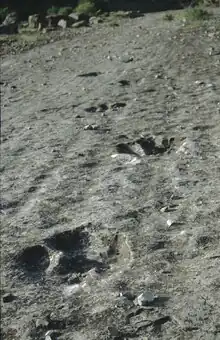Dinosaur Plateau
Dinosaur Plateau (Turkmen: Dinozawrlar platosy) is a large limestone slab lying on the slope of the Köýtendag mountains in the Lebap velayat of Turkmenistan. Its famous for having the world's largest number of dinosaur footprints found in one place.[1]

Location
The Dinosaur Plateau is located three kilometers southwest of the mountain village of Hojapil at a 1,500 meter altitude on the territory of the Köýtendag Nature Reserve, [2] within the Hojapil Sanctuary.
Legend
A local Turkmen legend says that the footprints of large animals belonged to the elephants from Alexander the Great's army which were left during his Asian campaign. Therefore, the nearby village was named Hojapil, which translates from the Turkmen as “sacred elephants”.[3]
Scientific discovery

The name of the village and the ancient legend about unusual footprints indicate that local residents were aware of them for a very long time. It was they who indicated the location of the traces to local Turkmen historians and geologists, who made scientific reports about it in the second half of the 20th century. Gradually, the entire scientific world became aware of the find, after which the Plateau was examined by specialists from the Paleontological Institute and the Institute of Geology of the USSR Academy of Sciences, and it was also repeatedly visited by groups of students from various universities.[1]
Description

The Dinosaur Plateau is approximately 400 meters long and 300 meters wide. In this area, scientists have discovered about 3,000 well-preserved dinosaur tracks and 31 trails. Such a number of dinosaur footprints have never been found anywhere else in the world. Megalosaurs moved along 26 paths, the longest of which were 195 meters, 226 meters, 266 meters and 311 meters long, which is a “world record.” Moreover, the footprints of Megalosaurus are the largest ever found whoich are related to the Jurassic period. All these data indicate that the Dinosaur Plateau in Turkmenistan is unique, having no equivalents on the planet.[1]
The scientists believe that the Dinosaur Plateau was created as follows. About 145-150 million years ago, at the end of the Jurassic period, there was the bottom of a shallow lagoon along which huge dinosaurs walked. Soon after this, the water receded and the former bottom dried out, turning into a solid layer of limestone. After millions of years, as a result of geological processes, tectonic plates collided and this area formed a pile of rocks. The slab, which previously lay horizontally, tilted and rose to its current height. After another few million years, the softer rocks were eroded by water and winds, and the area with the dinosaur tracks was exposed.[4]
UNESCO World Heritage
Currently, the government of Turkmenistan is working to include the Dinosaur Plateau on the UNESCO World Heritage List.[5]
References
- "Плато динозавров в Туркменистане". Туркменистан, интернет портал о культурной, деловой и развлекательной жизни в Туркменистане (in Russian). 2023-09-09. Retrieved 2023-09-13.
- "Плато динозавров – легенда о Македонском • Alpagama". Alpagama (in Russian). 2020-08-25. Retrieved 2023-09-13.
- "Плато динозавров – легенда о Македонском • Alpagama". Alpagama (in Russian). 2020-08-25. Retrieved 2023-09-13.
- "Плато Динозавров, Магданлы". www.advantour.com. Retrieved 2023-09-13.
- "Туркменское Плато динозавров будет включено в Список Всемирного наследия ЮНЕСКО". Портал СНГ (in Russian). Retrieved 2023-09-14.